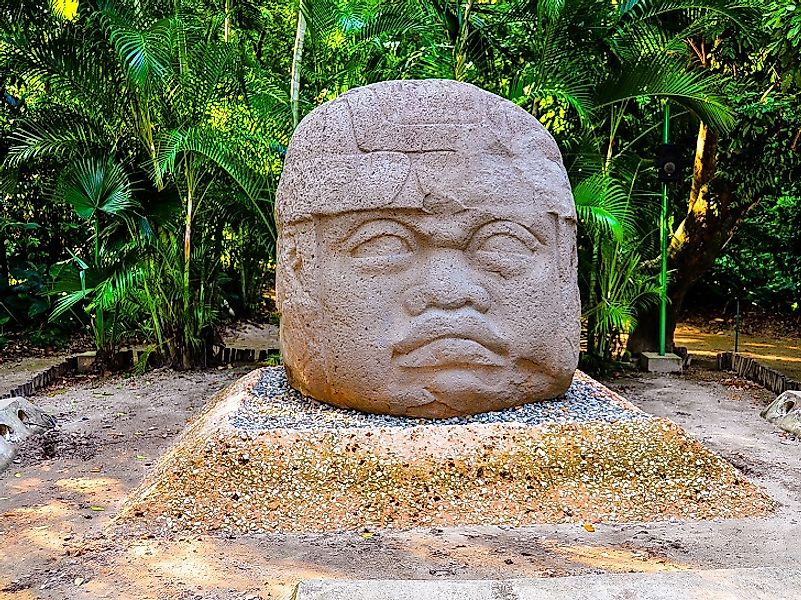Olmec People Of Ancient Mexico

The Olmec is a mysterious civilization that thrived in Mexico between 1200 BC and 400 BC. The Olmecs are considered to be the ancestors of all the better known cultures of Mesoamerica like the Maya and the Aztecs. We know the Olmecs from their monumental religious complexes and massive stone sculptures and their preferences for ball games and drinking chocolate. However overall, the Olmecs remain a source of mystery. Scant archaeological evidence does not reveal their ethnic or geographical origins and the extent of their settlements. The Olmecs did record their gods and rituals with symbols, which suggest an organized religion involving priesthood, holy sacrifices, pilgrimages and pyramid-building. The Olmecs passed on their traditions to all of the subsequent Mesoamerican civilizations up to the Spanish conquest in the 16th Century.
4. Work, Trade, and Recreation
The Olmecs started off by gathering the plant food and palm nuts and hunting turtles and clams. Then exploiting the fertile coastal areas of the Gulf of Mexico and grew crops like corn and beans, often twice in a single year, which allowed them build up an agricultural surplus. The earliest urban settlement was at San Lorenzo, followed by La Venta, Tres Zapotes, Laguna de los Cerros, and Las Limas. By 1200 BC, they had an extensive trade network that reached as far south as modern Nicaragua. The Olmecs traded in obsidian, serpentine, jade, mica, pottery rubber, and feathers. The Olmecs were seemingly obsessed with polished mirrors of magnetite and ilmenite. By San Lorenzo was in a strategic position to control local trade and had reached its height of prosperity and regional influence by 900 BC. When the Spanish arrived, they observed the Aztecs playing a ball game, which was invented by the Olmecs. The name Olmec is derived from an Aztec term meaning ‘rubber people’, probably from the Olmec enthusiasm for playing ball games.
3. Cuisine, Art, and Culture
The most striking art works of the Olmec civilization were colossal stone heads. Most of them were carved in basalt and display powerful facial features, which may be considered images of actual rulers. Some heads are nearly 3 meters high and can weigh 8 tons. The subject usually wears a helmet with jaguar paws hanging over the forehead, a symbol of political and religious power. San Lorenzo, La Venta, and Laguna de los Cerros were symmetrically planned cities with carefully arranged architectural layouts of religious centers. The first pyramid in Mesoamerica was built in La Venta, which had four, strategically placed, gigantic heads acting as guardians of the spiritual complex. At the same city, a sunken plaza was lined with 2-meter high basalt columns and smaller pyramids. The most striking art works of the Olmec civilization were colossal stone heads. Most of them were carved in basalt and display powerful facial features, which may be considered images of actual rulers. Some heads are nearly 3 meters high and can weigh 8 tons. The subject usually wears a helmet with jaguar paws hanging over the forehead, a symbol of political and religious power. Other art works included rock carvings, cave paintings and sculptures made of jade, ceramic and stone.
2. Language and Religion
The Olmecs appear to have revered natural places that connected the sky, earth, and the nether world. The names of Olmec gods are unknown but like most pagan religions, they represented natural phenomena like rain, earth and animals. They Olmecs attached special significance to animals on the top of the food chain like jaguars, eagles, snakes, and sharks. These were identified as divine beings and probably thought that powerful rulers could transform themselves into such fearsome divinities at will. Their supreme deity may have been a creature half human and half jaguar. They also worshiped a sky dragon and believed four dwarfs held up the sky in the four cardinal directions. These gods were worshiped in elaborately planned religious centers, with precise alignments and huge step pyramids. All these Olmec gods and the construction of their shrines retained their importance with later Mesoamerican cultures. The Olmecs did have a writing system but no continuous script has survived from which to decipher their language.
1. Decline of the Olmecs
The Olmec civilization is characterized by the systematic and periodic destruction of its principle cities. It happened with San Lorenzo around 900 BC after which La Venta rose to prominence with a population of 18,000. Around 400 BC, La Venta too suffered a deliberate destruction of its buildings and monuments. The entire civilization abruptly and mysteriously vanished around 300 BC. Nonetheless, from the Aztecs nearby to Maya further away, the Olmecs would influence other indigenous American cultures for centuries to come, and such Olmec influences are still felt in the culture of Mexico and surrounding areas even today.







